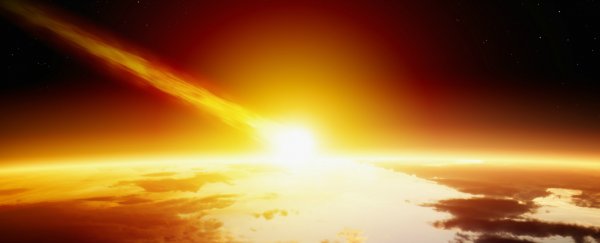Roughly 66 million years ago, a 9-km-wide asteroid slammed into Mexico's Yucatán Peninsula, starting a series of unfortunate events that ultimately led to the extinction of the dinosaurs. It was a turning point for our planet, but until now, scientists have never been able to analyse the impact crater or the buried remains of the asteroid - mostly because the region is so tightly controlled by the oil industry.
But a team of researchers led by the University of Texas at Austin has finally received permission to set up a drilling platform above the crater, and at the start of next month they'll drill deep below the seafloor and into the Chicxulub crater for the first time. They hope what they'll find will help them put together the missing pieces that explain what happened after the asteroid hit.
"It seems like a lifetime's ambition coming true," co-lead researcher Joanna Morgan from Imperial College London told Science.
We already have a rough picture of what happened that fateful day - Chicxulub struck, released the energy of 1 billion Hiroshima bombs, killing nearby animals and plants instantly. In the years that followed, at least 75 percent of all species on Earth are estimated to have disappeared.
Some scientists have suggested that the impact triggered a cascade of volcanic eruptions worldwide, which filled the atmosphere with poisonous gases for the next 500,000 years, causing the majority of those deaths. Another paper suggests that it was debris from the natural disasters following the impact, such as tsunamis and earthquakes, that caused the mass die-off.
Retrieving samples of Chicxulub could be our best chance of finding out. The team will spend the next few months using a diamond-tipped drill bit to drill round the clock. The ultimate goal is to get 1,500 metres below the ocean floor into the crater's 'peak ring'.
The peak ring is that elevated ring that surrounds impact craters, and although they're immediately recognisable, scientists still don't understand what they're made of or how they form. "Chicxulub is the only preserved structure with an intact peak ring that we can get to," said co-lead researcher Sean Gulick from the University of Texas at Austin. "All the other ones are either on another planet, or they've been eroded."
The samples retrieved from the drill hole will also provide insight into how life rebounded after the mass extinction - something that could come in handy one day if we ever come face-to-face with an asteroid again.
There's also the possibly that the Chicxulub asteroid might have actually brought life to Earth, and the researchers will be analysing the genes of any microbes living in the rocks, especially those that could have unique metabolic pathways.
"Those genes might show that peak ring microbes - descendants of those that lived after the impact - derive their energy not from carbon and oxygen, like most microbes, but from iron or sulphur deposited by hot fluids percolating through the fractured rock," writes Eric Hand for Science. "And that would mean the impact crater, harbinger of death, was also a habitat for life."
The drilling is scheduled to start April 1.
